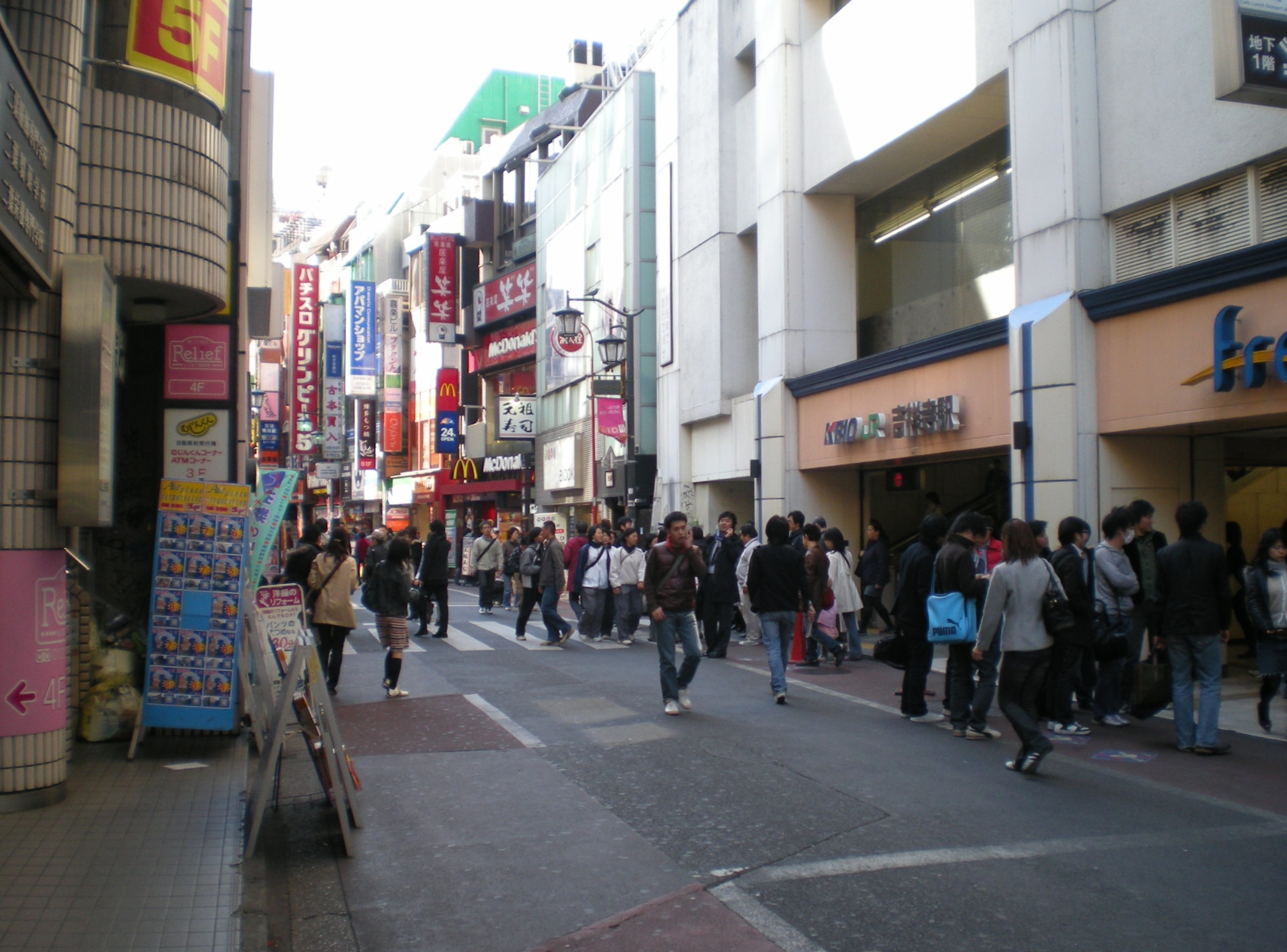Kichijōji Station on:
[Wikipedia]
[Google]
[Amazon]
is an interchange passenger
 *
*
JR East station information
{{DEFAULTSORT:Kichijoji Station Railway stations in Japan opened in 1934 Chūō Main Line Chūō-Sōbu Line Stations of East Japan Railway Company Keio Inokashira Line Railway stations in Tokyo Railway stations in Japan opened in 1899 Musashino, Tokyo
railway station
Rail transport (also known as train transport) is a means of transport that transfers passengers and goods on wheeled vehicles running on rails, which are incorporated in Track (rail transport), tracks. In contrast to road transport, where the ...
serving Kichijōji
__NOTOC__
is a neighborhood in the city of Musashino in Western Tokyo, Japan. It is centered on a compact but popular commercial area to the north and south of Kichijoji Station, with a full range of shops, restaurants, bars, and coffee hous ...
in the city of Musashino, Tokyo
is a city located in the western portion of Tokyo Metropolis, Japan. , the city had an estimated population of 147,492 in 77,779 households, and a population density of 13,000 persons per km². The total area of the city is . Based on the 2015 K ...
, Japan, operated by East Japan Railway Company
The is a major passenger railway company in Japan and is the largest of the seven Japan Railways Group companies. The company name is officially abbreviated as JR-EAST or JR East in English, and as in Japanese. The company's headquarters ar ...
(JR East) and the private railway
A private railway is a railroad run by a private business entity (usually a corporation but not need be), as opposed to a railroad run by a public sector.
Japan
In Japan, , commonly simply ''private railway'', refers to a public transit railway o ...
operator Keio Corporation.
Lines
Kichijōji Station is located on the JR EastChūō Main Line
The , commonly called the Chūō Line, is one of the major trunk railway lines in Japan. It connects Tokyo and Nagoya, although it is the slowest direct railway connection between the two cities; the coastal Tōkaidō Main Line is slightly faste ...
, and is served by all-stations Chūō-Sōbu Line services from and some Chūō Line (Rapid)
The is the name given to rapid services on the eastern section of the Chūō Main Line operated by the East Japan Railway Company (JR East) between and stations. The official map shows services travel as far as Otsuki.
Basic data
*Operato ...
limited-stop services from . It also forms a terminus
Terminus may refer to:
* Bus terminus, a bus station serving as an end destination
* Terminal train station or terminus, a railway station serving as an end destination
Geography
*Terminus, the unofficial original name of Atlanta, Georgia, United ...
of the Keio Inokashira Line
The is a railway line operated by the Japanese private railway operator Keio Corporation in the western suburbs of Tokyo, connecting in Tokyo with in Musashino City. It is not physically connected to the Keio Main Line Network, but a transf ...
and is located 12.7 kilometers from the opposing terminus at in Tokyo. The station is 14 minutes from Shinjuku and 28 minutes from Tokyo by Chuo Line rapid service, and 23 minutes from Shibuya by Inokashira Line express service.
JR East
Station layout
The JR East station consists of two elevatedisland platforms
An island platform (also center platform, centre platform) is a station layout arrangement where a single platform is positioned between two tracks within a railway station, tram stop or transitway interchange. Island platforms are popular on ...
serving four tracks. It has a "Midori no Madoguchi
, which stands for ''Multi Access (originally Magnetic-electronic Automatic) seat Reservation System'', is a train ticket reservation system used by the railway companies of former Japanese National Railways, currently Japan Railways Group (JR Gro ...
" staffed ticket office and a "View Plaza" travel agent.
Platforms
Keio
Station layout
The Keio station consists of two elevatedside platforms
A side platform (also known as a marginal platform or a single-face platform) is a platform positioned to the side of one or more railway tracks or guideways at a railway station, tram stop, or transitway. A station having dual side platforms ...
serving two terminating tracks.
Platforms
History
Kichijōji Station opened on 30 December 1899. The Keio station opened on 1 April 1934. From 22 February 2013, station numbering was introduced on Keio lines, with Kichijōji Station becoming "IN17".Passenger statistics
In fiscal 2019, the JR station was used by an average of 141,849 passengers daily (boarding passengers only) making it the 22nd busiest JR East station. Over the same fiscal year, the Keio station was used by an average of 146,901 passengers daily (exiting and entering passengers). The passenger figures for previous years are as shown below. * Note that JR East figures are for boarding passengers only.Surrounding area
 *
* Inokashira Park
is a park which straddles Musashino and Mitaka in western Tokyo, Japan. Inokashira Pond (井の頭池) and the , established during the Edo period, are the primary sources of the Kanda River.
The land was given to Tokyo in 1913. On May 1, 19 ...
See also
*List of railway stations in Japan
The links below contain all of the 8579 railway stations in Japan.
External links
{{Portal bar, Japan, Trains
*
Railway stations
Japan
Japan ( ja, 日本, or , and formally , ''Nihonkoku'') is an island country in East Asia. ...
References
External links
JR East station information
{{DEFAULTSORT:Kichijoji Station Railway stations in Japan opened in 1934 Chūō Main Line Chūō-Sōbu Line Stations of East Japan Railway Company Keio Inokashira Line Railway stations in Tokyo Railway stations in Japan opened in 1899 Musashino, Tokyo